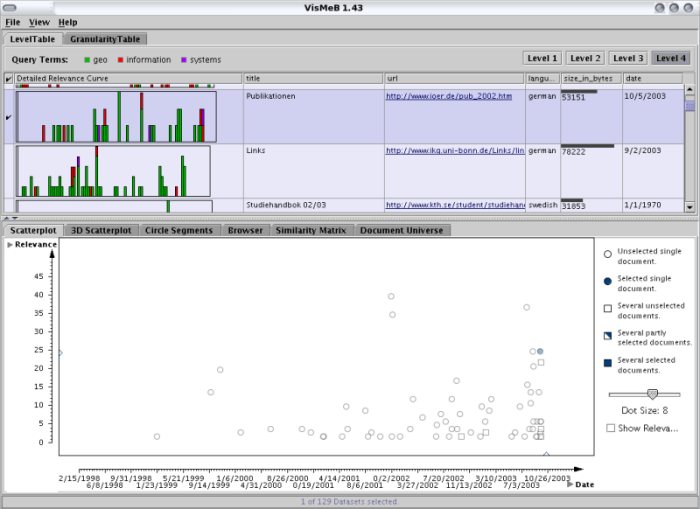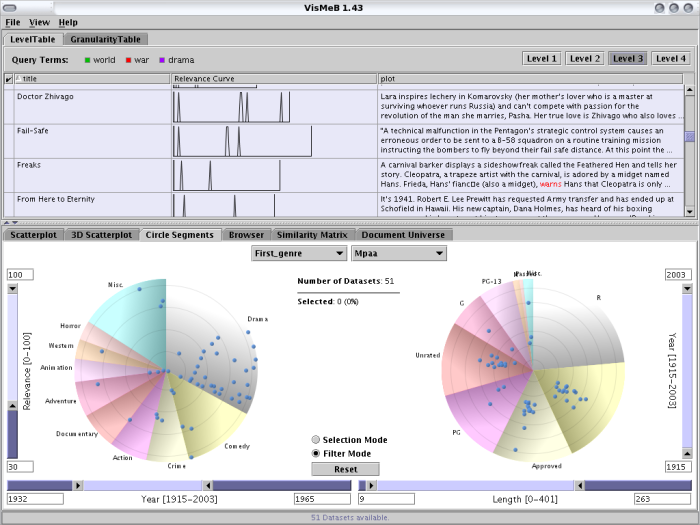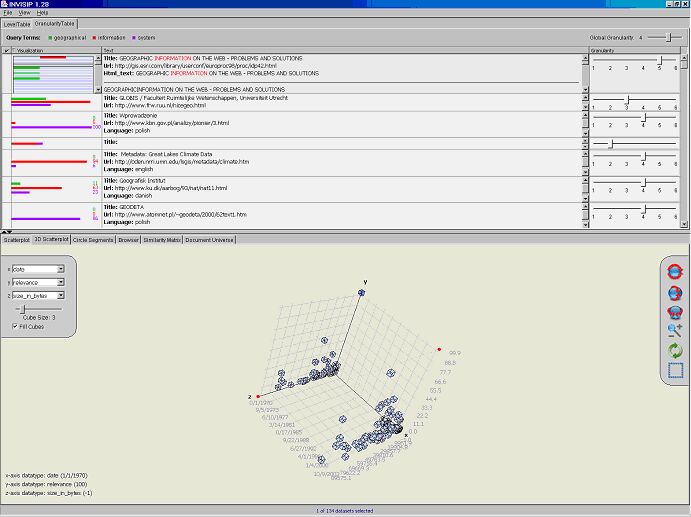VisMeB
A Visual Metadata Browser

Members
Reiterer, Limbach, Müller, Klein, Grün, König, Liebrenz, Gerken, Rexhausen, Obermüller, Memmel, Gundelsweiler, Jetter
Description
The project's main object of research is the design of Human-Computer Interaction in connection with the visualization of huge databases, such as digital libraries, the internet, data warehouses, or product databases. Considering the status quo in HCI research, the challenge is first and foremost on providing completely new forms of HCI by developing interactive visual artifacts not yet available as well as new techniques of interaction. At this point the realm of traditional GUI design is left for completely new ways of visual interaction with the medium computer. One objective is finding suitable visual metaphors for abstract data; usually metadata of a certain object are visualized, as for instance specific attributes of a web document (e.g. title, date of creation, size, language, relevance). A similar challenge is the design of intuitive ways of interaction (e.g. by making use of the different sense modalities, such as visual perception, speech, gesture, touch) that can be employed with a variety of hardware (e.g. wall-sized displays, PCs, PDAs). Still another challenge has to do with so called mobile devices that are becoming more and more integrated in work routine and the resulting ubiquitous computing.

This visualization project's efforts are aimed at supporting the user to find the relevant data as quickly as possible among the often huge amount of query hits. The vast amount of digital data available nowadays has long since lead to information saturation - therefore our objective becomes more and more important.
In the context of the research project VisMeB a visual metadata browser is to be developed that can be employed in a variety of user situations (e.g. search on the web, queries for geographical data in meta-databases, queries in pharmacological or medical online databases). VisMeB helps to generate a generic framework for the visualization of different metadata. The visualization shall be made adaptable to the respective metadata by means of a special configurational element (e.g. depends on type of data). The mentioned generic framework is not only meant to be compatible with various user domains (and thus applicable to different metadata standards) but also with different hardware (e.g. wall-sized display, 21\" desktop display, 12\" tablet display or notebook, 5\" PDA display or 3G cell phones). Not only traditional interaction techniques (e.g. direct manipulation) but also multi-modal ones are to be employed (e.g. script and speech recognition, speech direction, touch-screen display). One emphasis will be on extensively evaluating all research prototypes by methods of usability engineering. For this purpose several mock-ups and prototypes are to be designed and then evaluated concerning feasibility ("proof of concepts") as well as usability.
As preparation for implementing the ideas of VisMeB some groundwork has already been completed. For instance, visual information retrieval systems were developed in the context of two EU-projects. For INSYDER ("Information Systeme de Recherche"), another research project, a web crawler was designed that uses various kinds of information visualization besides the traditional one, the listing, to display the search results (e.g. ResultTable, Scatterplot, bar charts, tile bars). The know-how gained during the Insyder project was used for a subsequent project called INVISIP (Information Visualization for Site Planning). INVISP, again, is concerned with the development of a visual browser system; it is meant to support architects, site planners and the like to find relevant data for site planning. The visualizations developed with INSYDER underwent a comprehensive evaluation with 40 users, the focus being on the analysis of usability. The results lead to new visualizations called SuperTable and Scatterplot. SuperTable employs drill down and roll up techniques that allow for the user to select relevant lines/parts and have them displayed in different gradations of granularity by drilling down (e.g. moving the sliders for granularity). Moving the slider in another direction causes a respective rolling up that diminishes the granularity of information representation. For instance, the finest-grained gradation shows the complete web-document with highlighted keywords. These operations called "focus of interest" can be applied to selected data as well as to the complete visualized data. To support the focus of interest so called focus and context techniques were integrated into SuperTable and Scatterplot.


VisMeB Video - Introduction & Usage Scenario
External Page
To view this content (source: www.xyz.de ), please click on Accept. We would like to point out that by accepting this iframe, data could be transmitted to third parties or cookies may be stored.
You can find more information on our privacy policy .
External Page
To view this content (source: www.xyz.de ), please click on Accept. We would like to point out that by accepting this iframe, data could be transmitted to third parties or cookies may be stored.
You can find more information on our privacy policy .
Publication list
